Welcome to the story of two young dreamers building an unconventional home.
We’ll be adding ideas, sketches, and drawings as they are developed. Feel free to revisit this page to look for updates, or subscribe and we’ll let you know when they happen.
There’s a lot to cover here, and we’ve really only just begun…
So let’s break down this design into the principles we developed for ourselves at the beginning of this mission.
Small Footprint
Net Zero
Passive House
Prefabrication
Healthy Living
Where We Are Building
We have already acquired a piece of land in South-Central Pennsylvania (Perry County) that is about 3 acres in size. The property is not terribly far from where the two of us grew up, and it’s covered and surrounded by trees.
We LOVE trees, that is probably obvious – but that love is also our achilles heel: we hate cutting them down. None-the-less, we will need to take a couple trees down in order to live amongst them~ we will need decent solar access for our solar roof, as well as a flat-ish section of land on our sloped property for easy accessibility.
To truly mitigate the impact we are about to have on this beautiful piece of land…In order to have a “small footprint” and take responsibility for what alterations we do inflict upon the forest… we believe that means we must intimately get to know the land we are about to inhabit. So, we are taking the time to identify the trees that cover our skies and the plants that blanket our undergrowth. We have Chestnut Oaks galore, and a multitude of Sassafras saplings. We have one particularly grandiose American Beech, and plenty of smell-good Black Birch. We have Black Gum, Witch-Hazel, Red Maple, Black Oak, Eastern White Pine, and the poorly afflicted Hemlock…which could perhaps live up to 600 years if not for the invasive woolly adelgid.
The undergrowth has wild blueberries and trying saplings… and we did identify and remove one invasive species: the Japanese Barberry Bush.
However.
Towering over the struggling saplings, and reaching heights almost as high as the Witch-Hazel…is a twisty-turny evergreen bush. In the spring it blooms delicate white and pink flowers, beautiful to behold…but deadly to consume. Creating habitats and a healthy undergrowth on the hill tops of the Appalachians, it is Mountain Laurel. Our property is wonderfully blanketed in it ~ earning our hills the name, “The Land of the Laurels.”
The Land of the Laurels
Appropriately Sized Home
To further minimize our impact on the land, our home’s physical footprint will be small. It will be the size of a two-piece modular home. We are attempting to make efficient use of small spaces for an anticipated family of five (as in us and possibly 3 children), while still maintaining ADA accessibility.
There will be a loft area above the private spaces to the East, which of course is not wheelchair accessible, but the stairs are to ADA standards. This space is intentionally undefined at the moment. It will house our home battery, ventilation system, and other mechanical items and could potentially be an extra bedroom space or play area for kids.
We have our kitchen and living space in what we are calling our “Great Room” to the West, with lots of operable glazing, a living wall, and the stair to the loft. There are 1.5 baths, with the full bath being completely accessible. The bedroom to the Northeast would become a kids’ bedroom with bunks, and the bedroom to the Southeast would be our bedroom during the night, and our office space during the day.
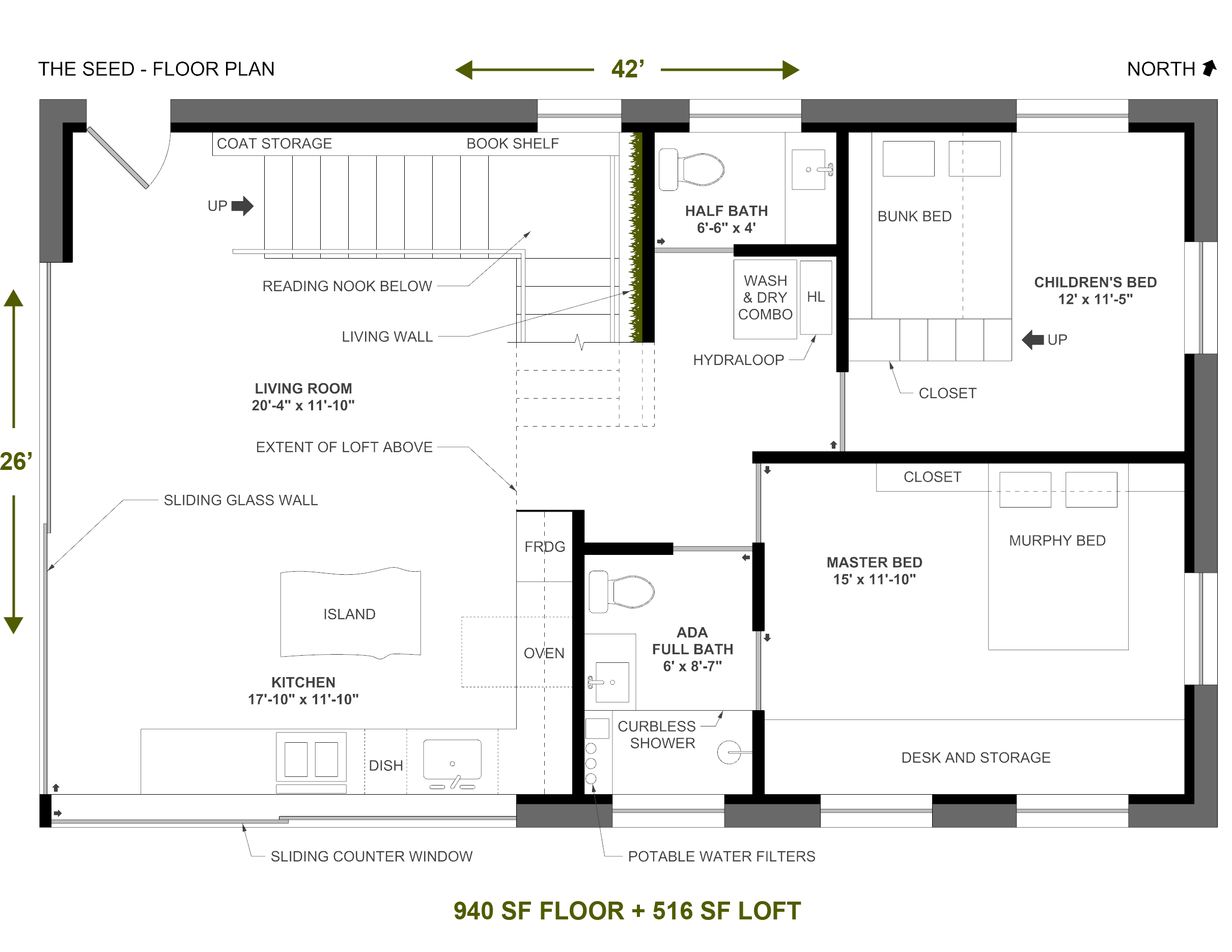
Home’s Foundation
The footprint of our foundation will be small, too. We are aiming to use a pin or helical pile foundation, which would create less of an impact on soil integrity and groundwater flows. Either of these foundations are also ideal for prefabrication purposes since there is no need to dig! The rendered image of the pin foundation (below) shows what the pins would look like in the ground – they need only be installed by a couple individuals and a jack-hammer, so no heavy machinery.
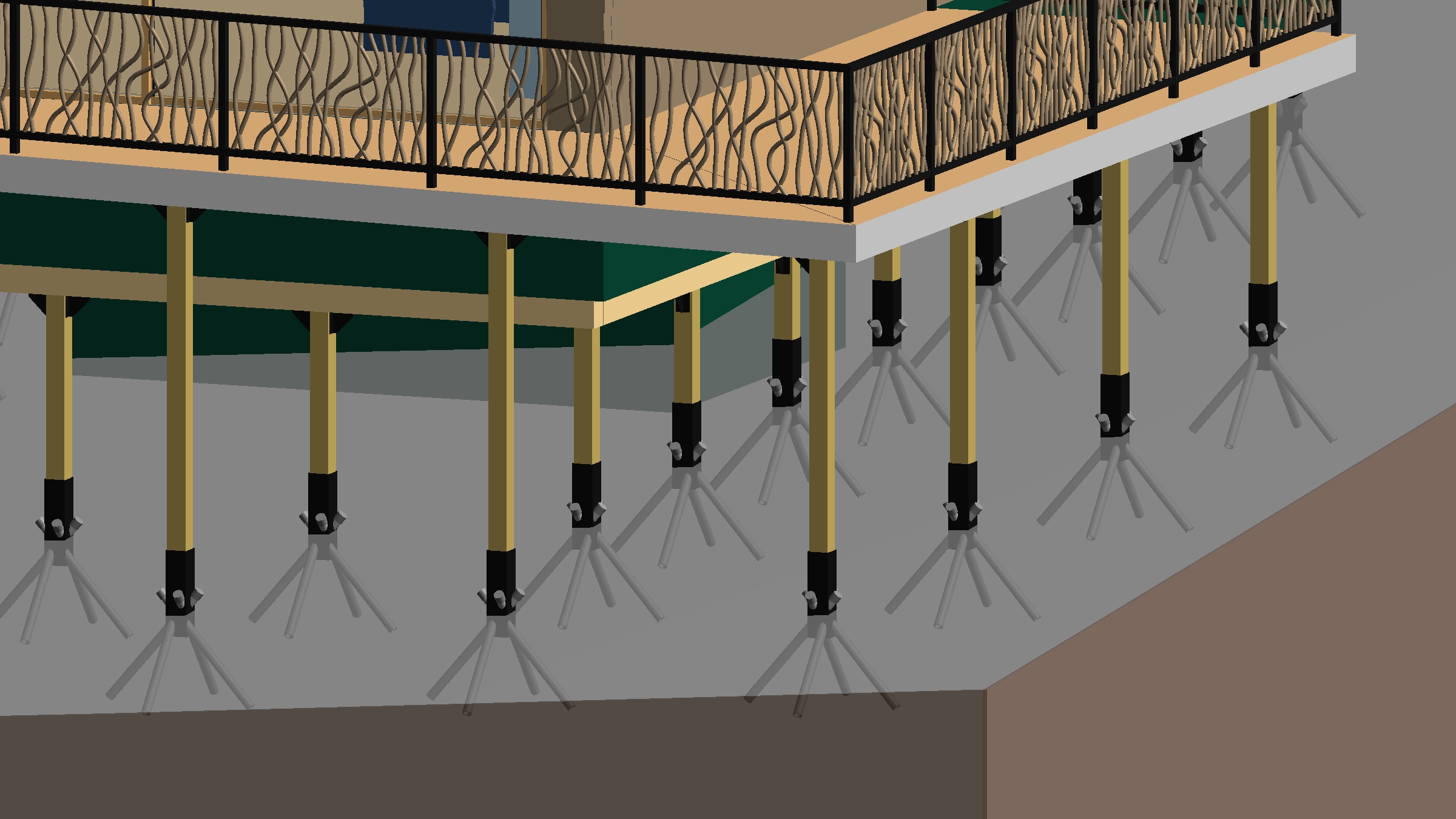
Our Materials
The materials we use and where they come from will also have an impact on our site and the greater environment around us. To lessen this impact and to meet the Materials Petal of the Living Building Challenge (LBC), we are looking for as many “locally” sourced materials as possible. To be a little more specific on what the LBC considers “local” certain percentages of our materials must fit within certain distances from our site, you can see those distances below. The green labels are cities for reference. The red labels are the locations of manufacturers’ production facilities of the products we would like to use. This map is in progress and there are a great deal more products to find and verify!
All of these materials also need to be sustainably obtained or salvaged, renewable, healthy, and recyclable or compostable. The home will also be built to last as long as possible and it should be able to withstand forms of natural disaster as well as multiple generations. However, nothing lasts forever, and the materials’ end-of-life needs to be recognized too. We’re going to strive to put everything together in a way that they can later be easily and decisively taken apart for reuse, compost, or recycling.
For a quick peek into how the material vetting process is currently working out for us, you can read a blog about it here.
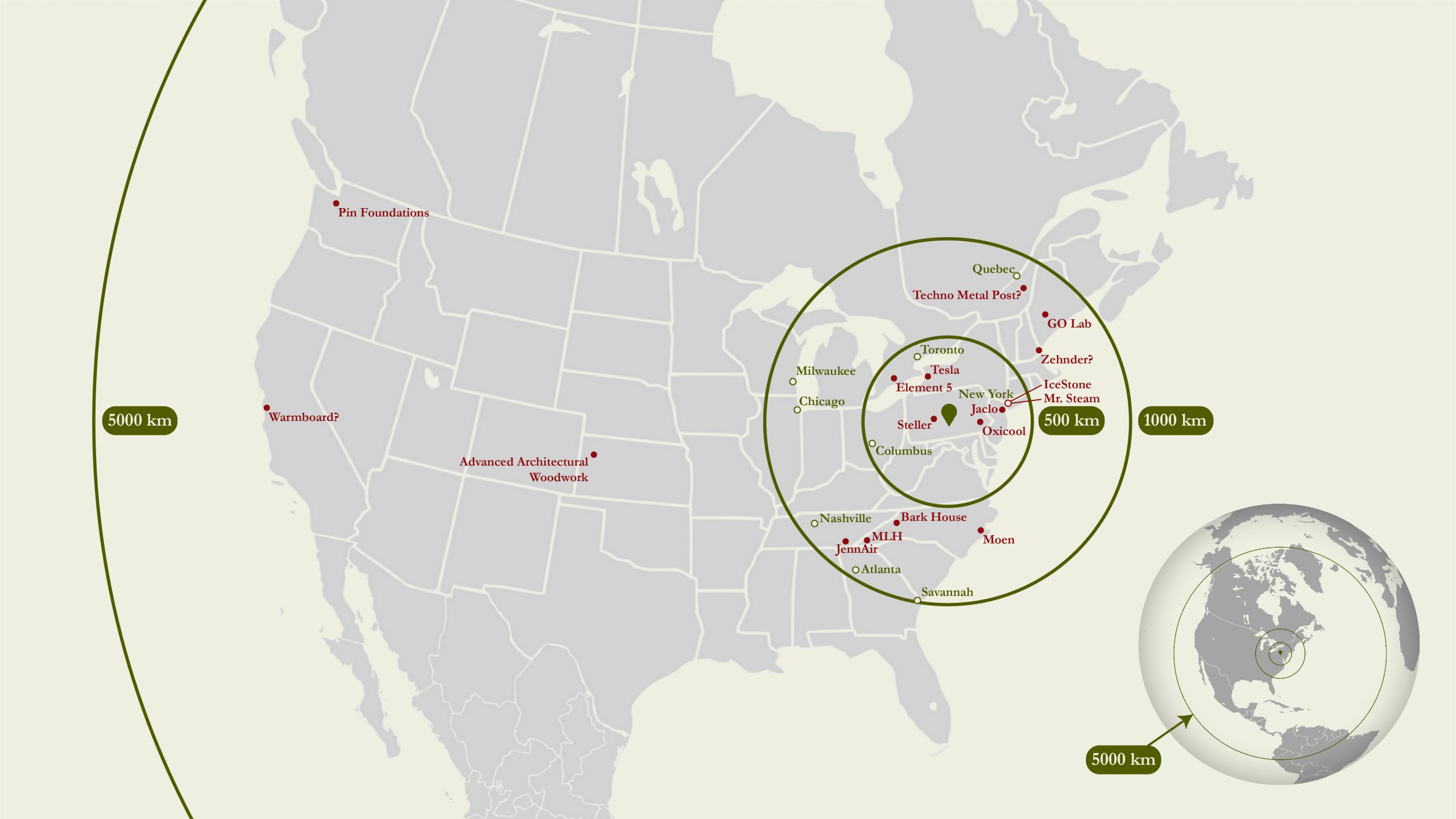
Net Zero Energy
An energy efficient home with a solar roof, battery storage, and wind turbines, should give us the potential to be off-grid. We would like to use Tesla’s solar roof and powerwall for our main source of electricity, but we are still mapping the specific orientation and location of our home to maximize solar energy gain. We of course would like to cut down as few trees as possible…which is proving to be difficult. With plenty of Chestnut Oaks and Eastern White Pines on our property, which can grow up to 100’ tall and live up to 250 years…we are going to have to combine a reliance upon wind energy with our solar. We are especially interested in the Powerpod by Utah-based Halcium Energy, which is admittedly still in development at this time.
We are hoping to be efficient with our heating loads while still avoiding harmful refrigerants commonly found in heat pumps, by using Warmboard’s hydronic radiant flooring.
We also intend to have “a brain” or connected smart home systems’ which will keep track of our energy and water consumption: how much water we have left in our pillow and energy left in our battery.
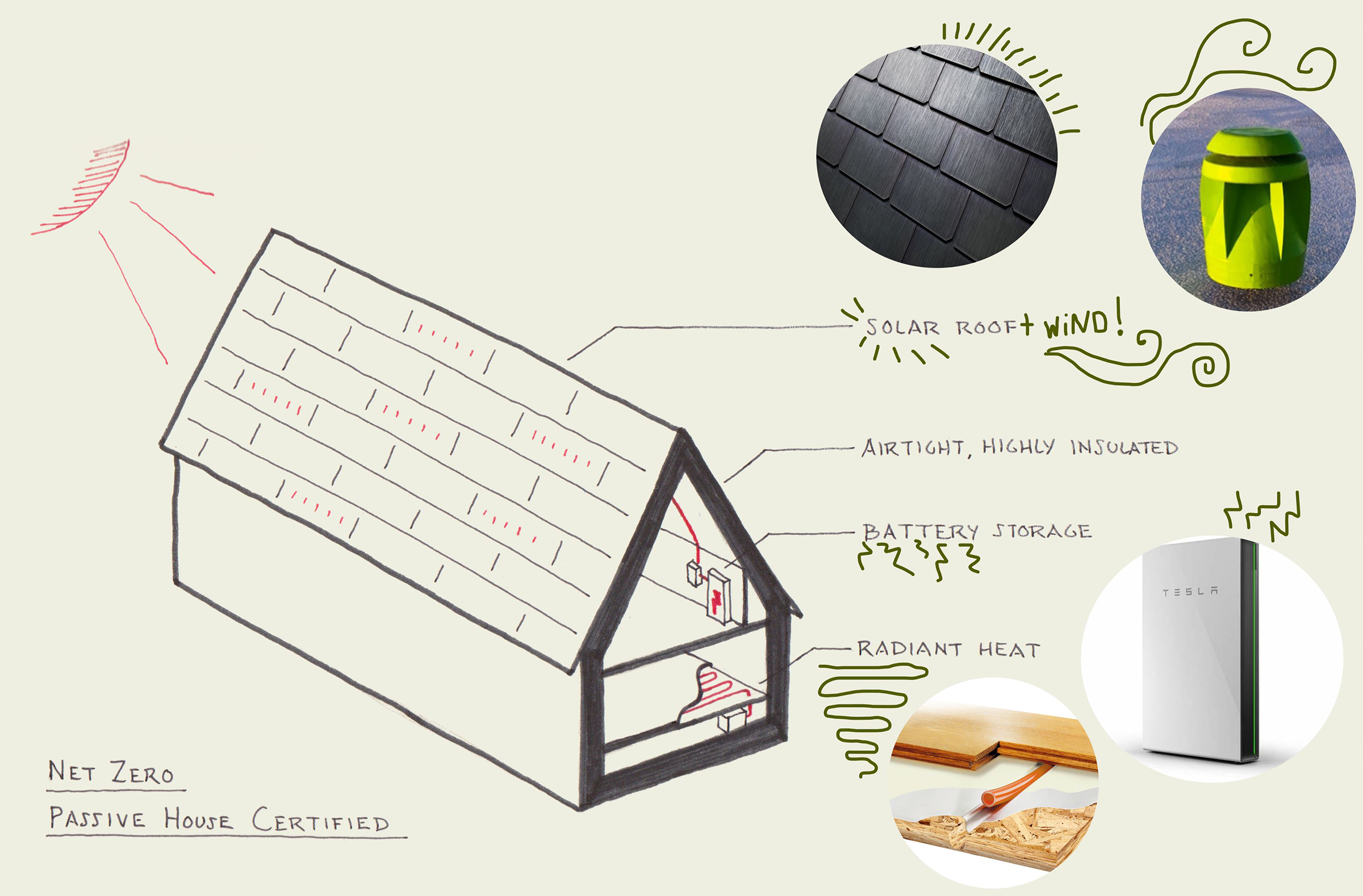
Net Zero Water
This idea is a bit of “doozey.” The plan we’ve developed below to harvest, use, treat, and reuse our water is complicated. We have begun discussing this plan with code officials (both local and state). It will continue to develop as we continue to discuss with officials and manufacturers. If you would like to read a detailed explanation on how this whole system works through the narrative of a water droplet who just happens to land on our roof… yes, it is indeed just as much fun as it sounds… you can read more here.
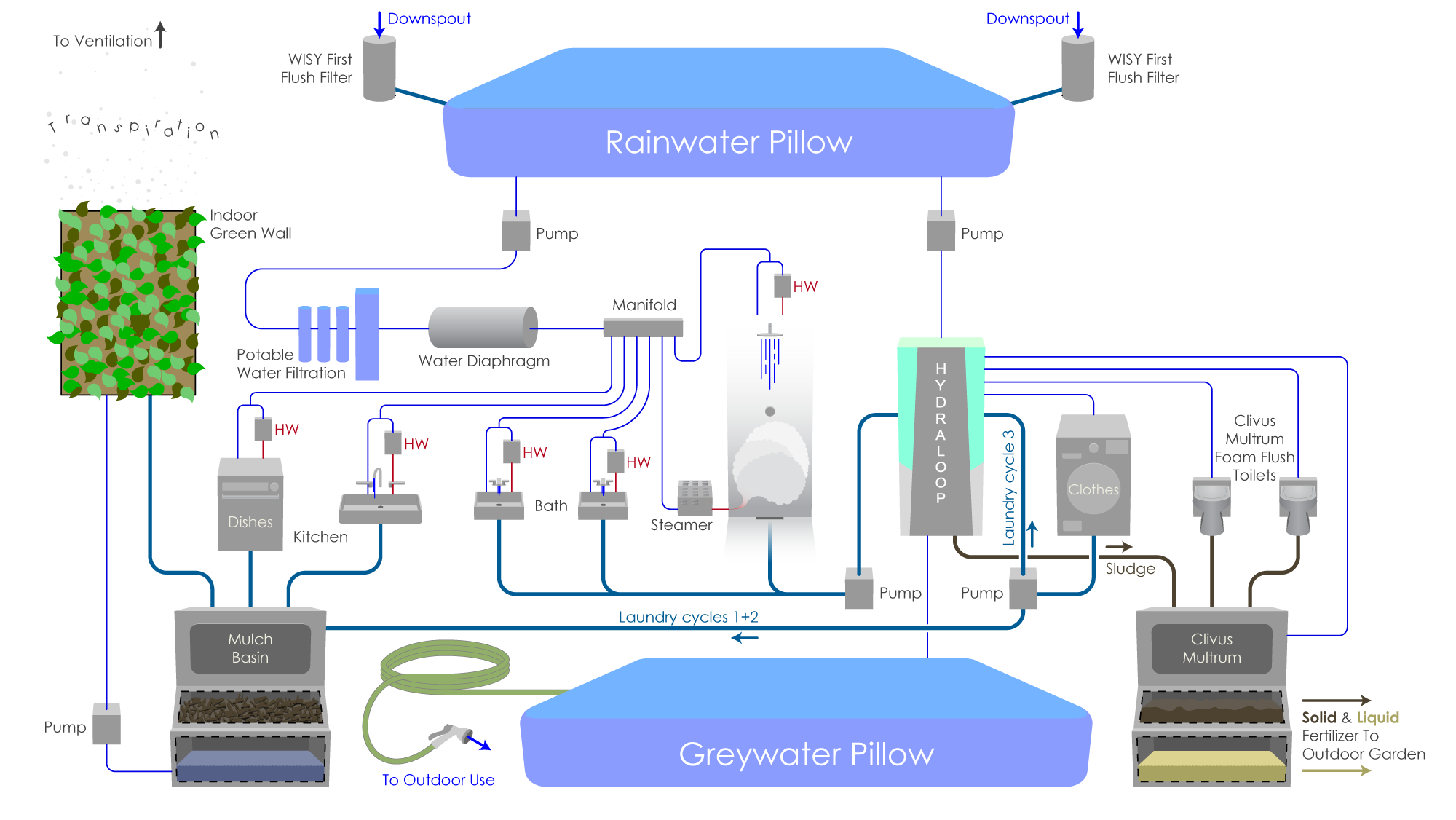
Energy Efficiency
We are designing our home to meet Passive House, specifically PHIUS, standards. Therefore, our home will be built to support energy efficiency.
To help us achieve the Passive House standard and embody as much carbon as possible, the design of our building envelope is of course a priority.
Following Joseph Lstiburek’s concept of a “perfect wall,” our wall will effectively hold up the home, keep water out, and keep it comfortable inside. Our structure, the CLT, which is also our interior finish, will be protected at the innermost layer with an air, water, and vapor barrier applied directly on top of it. A thick layer of continuous wood fiberboard insulation will set directly over that, penetrated only by thermally broken z-girts which hold up our rainscreen. Our rainscreen is made of horizontal battens and poplar bark shingles.
This wall section not only is a literal drawing of the concept of Lstiburek’s “perfect wall,” but it also creates another concept we’ve created – using the whole tree! CLT can be made from lumber which is less desirable to timber companies like diseased and smaller diameter trees, wood fiber insulation can be made from sawmill saw dust remains, and bark shingles are taken off of already felled trees for timber~ reusing an otherwise wasted resource.
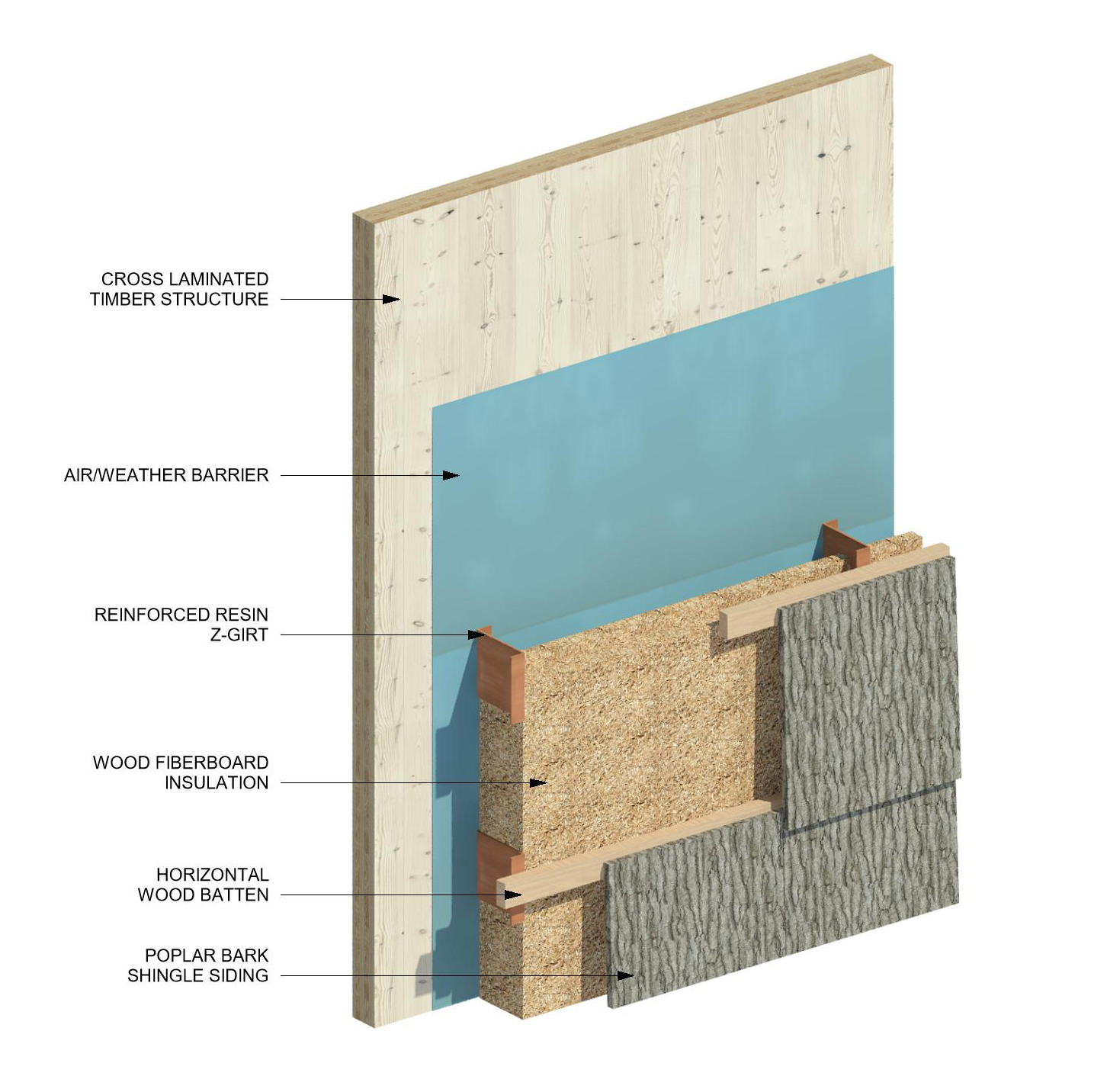
While we design and build…
We believe that holistically healthy, sustainable homes should be, and can be available to all. Therefore, we are keeping prefabrication concepts in mind as we build our own home~ how can we mass produce a Passive House and Living Building Challenge certified home to make it less expensive, and available to more people?
NOTE! Our home itself will not be prefabricated, we are just keeping these ideas and concepts in mind as we design and build.
In order for these kinds of homes…this mentality of sustainable building and living…to become the norm, they must be made affordable to more people.
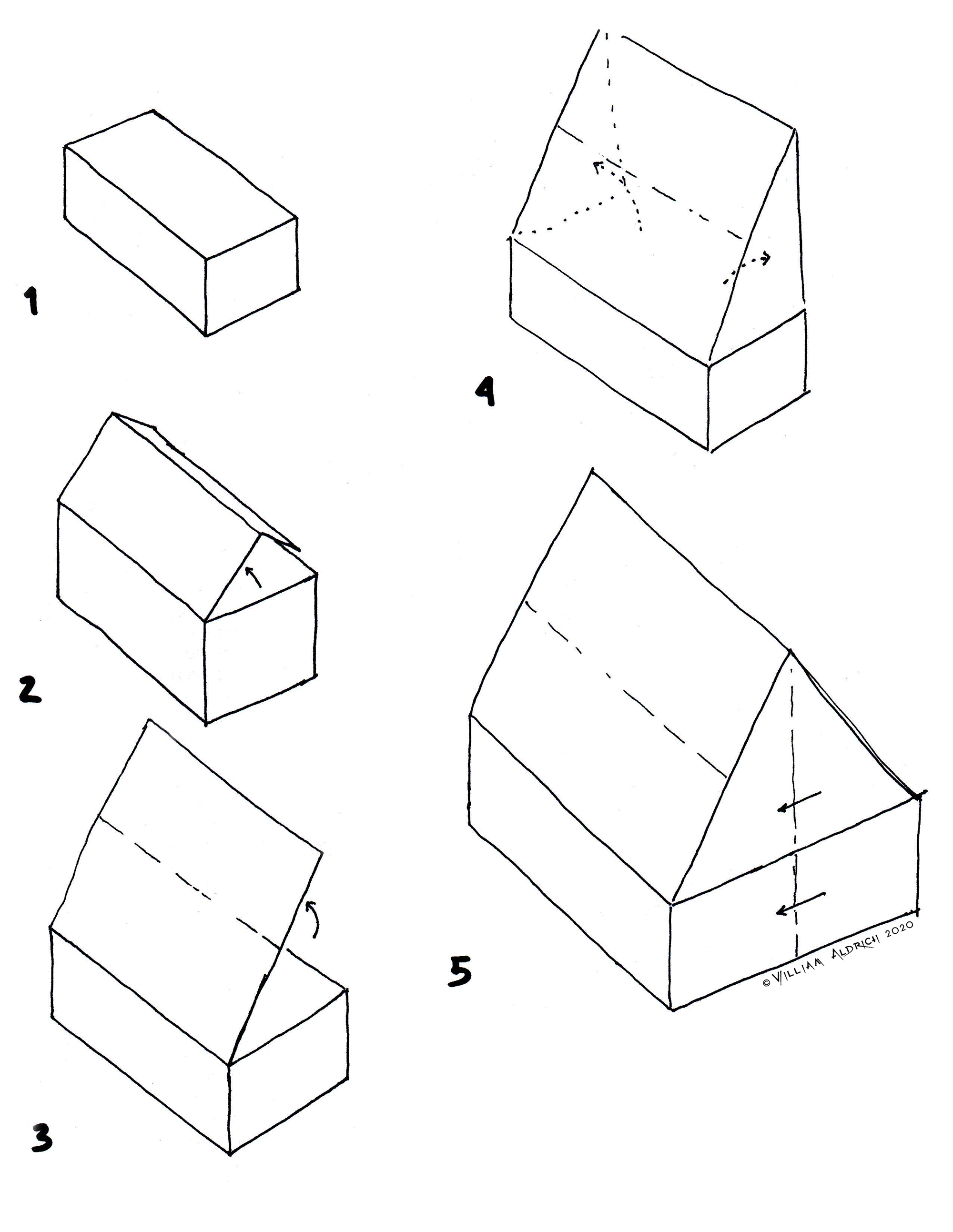

Accessibility- ADA Turning Radii, Door Approaches, Clear Spaces
Our home will meet ADA requirements ~ in a full capacity of not only accessibility to living necessities, but also to the enjoyment and interaction with the forest the home is in.
A wise building advocate once told us: “we are all only temporarily able-bodied.” This home will be prepared to handle that reality.
We have made sure a wheelchair user can access all of the main spaces of the first floor, and everything else is still made to ADA standards.

Biophilic Design
Below, you will see views inside our home of our ‘great room.’ There will be a lot of biophilic design that provides functionality as well as a connection to the land the home is placed upon.
- Living Wall – Brings the outdoors, oxygen, and more green in, while also serving as our ‘absorption field’ for our treated kitchen and laundry effluent. So, it serves a function while also being a biophilic design element.
- Natural Light – Skylights keep the loft area well lit and closer to the open sky.
- Mountain Laurel Handrails – We intend to use the mountain laurel on our land that must be removed for the home and driveway’s placement to make our handrails~ both indoor handrails and outdoor.
- CLT – The wooden structure of our home also is our interior.
- Plywood cabinets – More wood!
- Walnut floors by Steller floors – Hardwood floor sourced mostly in PA which are designed to be easily installed, removed, and reused.
- Raw edge kitchen island and bookshelves – At least a tree is going to have to be removed to put our home and driveway in place. This tree will be reused for the island and (depending on size and quantity) bookshelves.
Sense of Place
We will have lots of operable windows that not only provide natural light and ventilation, but they will also expand the indoor living space to the forest.
In addition to the natural ventilation that the windows will provide, we will also rely on an Energy Recovery Ventilator to maintain the temperature and (especially with a greywater garden wall and sauna) humidity.
The cleaning products we use will be safe, not only because they impact our air quality and human health, but because it will have to pass through our greywater system.
© 2020 Sustaining Tree
© 2020 Sustaining Tree
